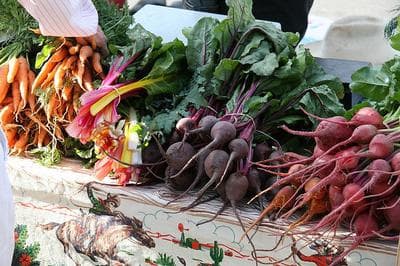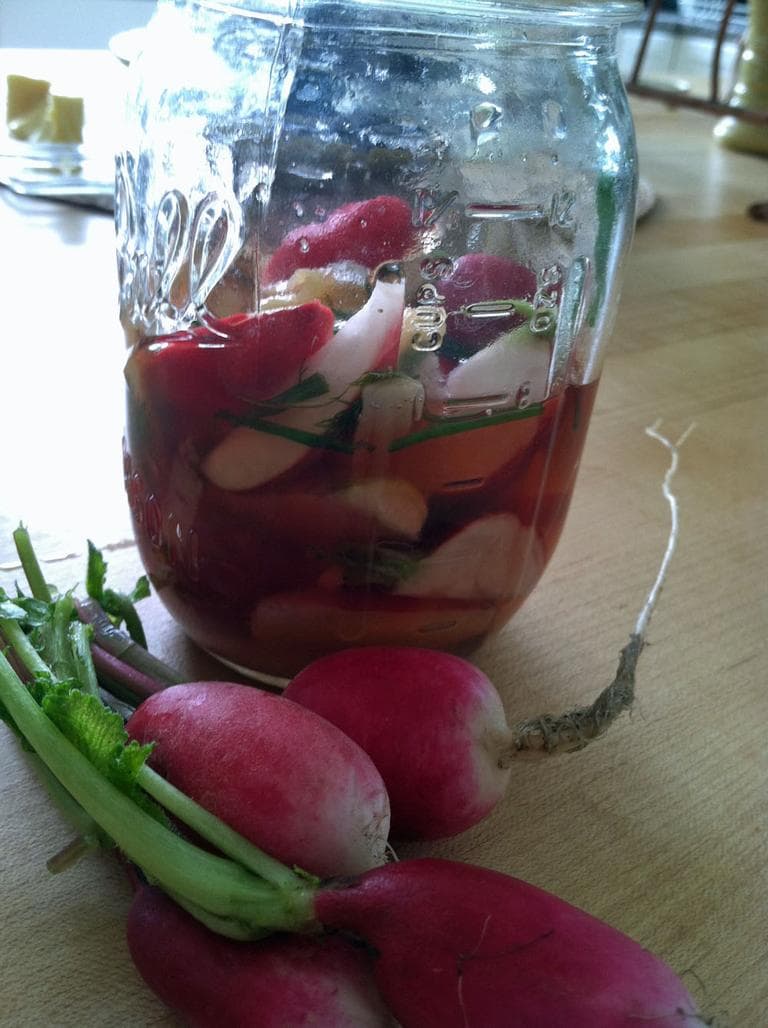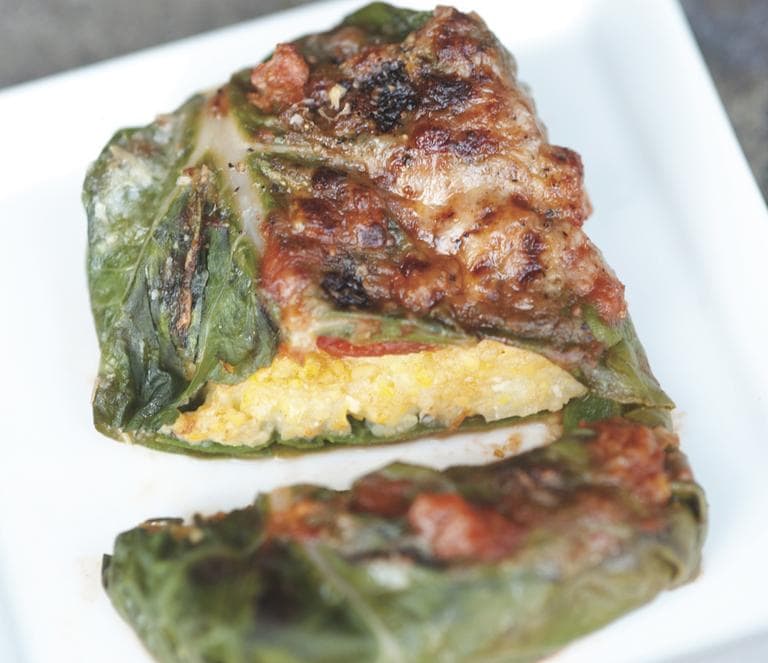Advertisement
Kathy Gunst Shares Some Lesser-Loved Summer Vegetables
Resume
When you think summer vegetables, tomatoes and zucchini come to mind. But Here & Now resident chef Kathy Gunst says there is so much more.
For example: the turnip. Kathy grew up hating turnips. Then she discovered a baby pink variety at a farmer's market. She took them home, roasted them, and as she tells Here & Now's Robin Young, "Juice poured out of the turnip into my mouth, sweet, delicious, earthy... I was like.. wait a minute, wait a minute! Where have you been all my life!"
Some of Kathy's favorite summer veggie recipes, all listed below, are: Ginger-Scented Pickled Radishes, Balsamic-Glazed Turnips and Baby Greens, Polenta-Stuffed Chard with Bubbly Parmesan, Swiss Chard Tart with a Potato Crust.
Kathy's Picks For Summer Veggie Cookbooks
Ginger-Scented Pickled Radishes (printer friendly/pdf)

[sidebar title="Kathy's Note" width="345" align="left"]These are quick pickles that you make in the refrigerator--no canning or week-long pickling process required. Use any type of radishes you have on hand. The pickles are ready to eat within two hours and should be consumed within a day or two. Serve with salads, grilled foods, as an appetizer with drinks, or on top of noodle dishes or stir fries.[/sidebar]
5 ounces radishes
1 tablespoon fresh dill and/or chives, chopped
2/3 cup rice wine vinegar or apple cider vinegar
2 tablespoon sugar
1 tablespoon fresh ginger, peeled and cut into very thin slices
1/2 teaspoon salt
Rinse the radishes and cut into quarters (or in half if you have large radishes). Place in a glass bowl or small Mason jar with the herbs.
In a small saucepan heat the vinegar and sugar and bring to a boil. Add the ginger and salt and simmer for 2 minutes. Remove from the heat and let cool 5 minutes. Pour over the radishes and herbs, cover and refrigerate for 2 hours or overnight. Serve cold.
Balsamic-Glazed Turnips and Baby Greens (printer friendly/pdf)
[sidebar title="Kathy's Note" width="600" align="center"]I grew up believing that turnips were big, white waxed vegetables with a starchy, awful taste. Then I tasted baseball-sized purple-topped turnips, roasted in a 400 degree oven and was wowed! Turnips are sweet and juicy and make for excellent eating. Here they are roasted and tossed with balsamic vinegar (which gives them a gorgeous glaze) and then served with mixed winter greens.[/sidebar]
The Turnips
1 pound small or medium purple-topped or white turnips, greens trimmed and ends trimmed
1 1/2 tablespoons olive oil
Salt and freshly ground black pepper
1 ½ tablespoons balsamic vinegar
The Salad and Vinaigrette
4 cups baby mixed greens, (baby arugula, spinach, sprouts, etc)
1 ½ teaspoons Dijon-style mustard
Salt and freshly ground black pepper
1 tablespoon plain yogurt
1 tablespoon wine vinegar
½ tablespoon balsamic vinegar
3 tablespoon olive oil
Preheat the oven to 400 degrees. Cut large turnips into quarters, medium-size ones in half and leave small (1-inch or so) turnips whole. Place in a medium size roasting pan or oven-proof skillet and toss with the olive oil, salt and pepper. Roast for 15 minutes. Add the balsamic vinegar and toss to coat all the turnips. Roast another 15 or 20 minutes, tossing the turnips once or twice so they brown evenly on both sides, and roast until they are just tender when pierced with a small, sharp knife. Remove from the oven and let cool about 5 to 10 minutes until they are warm.
Meanwhile place the greens in the center of a large plate or bowl.
Make the vinaigrette: in a small bowl mix the mustard, salt and pepper. Stir in the yogurt. Add the vinegars and then the oil and stir to make a smooth dressing. The vinaigrette can be made several hours ahead of time; cover and refrigerate until ready to use.
Arrange the warm turnips around the edges of the salad plate or bowl. Serve the dressing on the side. Serves 2 to 4.
Recipe from "Notes from a Maine Kitchen" by Kathy Gunst (Down East Books, 2011)
Polenta-Stuffed Chard with Bubbly Parmesan (printer friendly/pdf)

[sidebar title="Cheryl's Note" width="250" align="left"]
These gorgeous green parcels, best eaten on a Sunday night in front of a fire, are both dramatic and comforting (think lasagna, but without the pasta, ricotta or mozzarella). Buy the largest Swiss chard leaves you can find, and keep in mind that the polenta takes an hour to chill.[/sidebar]
Serves 4
Kosher salt
3/4 cup (112 g) dry polenta (coarse cornmeal)
1 tablespoon butter
1 cup (8 0z) packed grated Parmesan cheese, divided
Pepper
1¼ cups (300 ml) your favorite marinara or tomato sauce
8 very large leaves Swiss chard, swished in cool water
Coat a 9½-inch (24 cm) square pan with cooking spray and line the bottom with parchment.
In a medium saucepan, bring 3 cups (725 ml) water and 1 teaspoon salt to a boil. Whisk in the polenta and reduce the heat to a gentle gurgle. Cook until thick and porridge-like, 10 to 15 minutes, whisking occasionally. Remove from the heat and stir in the butter, half the cheese and a generous pinch of black pepper.
Scrape the polenta into the prepared pan and smooth the top. Cool for 15 minutes at room temperature, then refrigerate until cold, at least 1 hour. (After 1 hour, cover with plastic wrap.) Unmold and cut into eight 4 x 2-inch (8 x 5-cm) rectangles. Wipe the baking pan dry and spread 1/2 cup (118 ml) of the marinara along the bottom.
Preheat the oven to 400°F (200°C) and bring a kettle of water to a boil. Have several layers of paper towels on hand.
Make a narrow, upside down v-shaped cut about halfway down each chard leaf to remove the thick central steam. Place the leaves in a large bowl and cover with boiling water. Let soften for 6 minutes. Remove to the paper towels and pat very dry.
To form the rolls, lay 1 chard leaf on a cutting board. Lay 1 polenta rectangle horizontally along the bottom of the leaf and spoon 1 teaspoon of marinara on top. Roll the leaf upwards burrito-like, encasing the polenta and transfer to the baking pan seam side down. Repeat, nestling the rolls next to one other. Spoon the remaining sauce on top and sprinkle with the remaining cheese.
Bake for 10 minutes, then slip under the broiler for 1 to 2 minutes to brown the cheese. Serve hot.
***
Recipe reprinted with permission from "RIPE" © 2012 by Cheryl Sterman Rule, Running Press, a member of the Perseus Book Group.
Swiss Chard Tart with a Potato Crust (printer friendly/pdf)
[sidebar title="Kathy's Note" width="600" align="center"]Instead of traditional pastry, the crust for this tart is formed from very thin slices of potato. The potatoes turn out to be perfect for the job since the outside edges turn a gorgeous golden brown and become crisp, like homemade chips. The tart makes a superb brunch dish (you could even add bacon to the filling for a tart that combines eggs, bacon, and potatoes all in one dish), or it can be served as an appetizer or main course. This recipe makes two tarts; serve them both or freeze one, tightly covered with foil, for up to three months.[/sidebar]
Each tart serves 4 to 6.
For the filling:
1 ½ pounds Swiss chard
2 tablespoons olive oil
1 large garlic clove, very thinly sliced
¼ teaspoon salt, or to taste
Generous grinding black pepper
2 eggs
2 cups ricotta cheese
1 teaspoon chopped fresh thyme
½ cup packed grated Parmesan cheese
For the crust:
2 large potatoes (8 to 10 ounces), unpeeled and scrubbed clean
4 tablespoons olive oil
2 teaspoons chopped fresh thyme
Pinch of salt
A few grindings of black pepper
2/3 cup grated Parmesan cheese
To make the filling, trim the ends of the chard and wash thoroughly; drain and dry. Coarsely chop the chard.
In a large skillet, heat the 2 tablespoons of oil over medium heat. Add half the garlic and half the chard and cook, stirring frequently. As the chard cooks down, add the remaining chard and garlic. Season with salt and pepper. Cook for about 10 minutes, stirring until the chard is just tender. Tilt the skillet to the side and pat up any excess liquid using a paper towel. Let cool.
To make the crust, very thinly slice the potatoes; they don’t need to be so paper-thin that they are see-through, but they should be quite thinly sliced. It’s fine if some of the slices are smaller than the others — the important thing is to make the slices fairly uniform in thickness. Create a thin layer of the potato slices on the bottom of two pie plates (preferably glass or Pyrex), slightly overlapping them to create a solid bottom “crust.” Gently tuck potato slices along the edges to create a border up the sides of the pie plates. When you’re done you should have a solid pie “crust.” Use any thin or oddly shaped potato slices to fill in any gaps. Discard the remaining slices. Drizzle 2 tablespoons of the oil over each crust, swirling the pan slightly so the oil spreads between the potato layers and drips to the bottom. Sprinkle with the thyme, salt, pepper, and cheese.
Preheat the oven to 400 degrees.
To finish the filling, whisk the eggs in a bowl. Whisk in the ricotta, salt, pepper, thyme, and Parmesan cheese. Add the cooled sautéed chard and mix well. Divide the filling between the two pie crusts and press down lightly.
Bake on the middle rack for 20 minutes. Reduce the heat to 350 degrees and bake for another 10 minutes. The potato crust should turn brown and crisp, and the filling should feel solid and firm when gently touched with your fingers. Let cool about 5 minutes before cutting into wedges.
****
Recipe from "Stonewall Kitchen Harvest" by Kathy Gunst, Jim Stott and Jonathan King (Clarkson Potter)
Guest:
- Kathy Gunst, Here & Now resident chef
This segment aired on July 2, 2012.